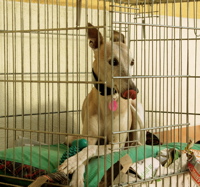Do you have a whippety question? Enter here your query or keyword.
- Home
- Whippet Training
- Dog Travel Crate
Dog Travel Crate
3 Good Reasons to Buy One Now!
The advantages of a dog travel crate are huge when it comes to housebreaking, traveling and fixing behavioural problems. Dog crate training tips for puppies and adult pets.
1 Use the Dog Travel Crate for Housebreaking

Any puppy, properly trained by his mother, will carefully avoid soiling his sleeping quarters and therefore his crate.
This behaviour will be very handy when you start housetraining your puppy.
Confine the pup in a room under your supervision and encourage him to use his crate, make it inviting with food, toys and soft bedding.
Once he has elected it to his private place, close the door for increasing period of time, never rushing and causing discomfort to your pet.
In no time you’ll be able to leave your dog alone in his crate when you can’t supervise him.
As soon as you allow your dog out of the crate take him to his toilet spot or for a walk.
If he eliminates, praise him and carry on with the walk.
Supervise your dog when he is outside the crate, if you catch him in the act of eliminating on your favorite carpet, say “No!” and quickly take him to his toilet area.
Don’t waste your time in reprimands if you discover the crime after it was committed: it's only your fault for not paying attention. Your dog is not spiteful or careless, he was not properly instructed to do the right thing.
Any late punishment will only convince your pet you routinely go mad for no apparent reason and you are not trustworthy.
Crate training a dog will become an effective and humane way to control and train your pet.
2 Use the Crate to Travel with Your Dog
Traveling with your pet will be easy and pleasurable if he is crate trained.
All airlines companies require that dogs travel in a kennel.
Metal foldable crates are spacious and easy to use in the house but keep in mind that for airline transport, you'll need a proper travel crate.
And don't forget to check the requirements of each airline company: they differ considerably and you want to arrive well prepared at the airport!
If your dog is already crate trained, even long trips won’t be stressful.
Once arrived, it will be easy for your dog to stay in an unfamiliar environment if he has access to his cozy little den.
If you are a guest, you won’t break a long time friendship because your dog destroys the heirloom carpet.
When you can’t supervise your puppy, he will be in his private quarters, sheltered from dangers and temptations.
3 Dog Travel Crate for Behavioural Problems
Crate training can be an effective answer to many behavioral problems.
A thunderstorm, fireworks, the owner's absence can be stressful for your dog and can result in typical anxiety behavior: door scratching, obsessive barking, furniture chewing, eliminating in inappropriate areas.
The judicious use of the crate can help you curb your pet anxiety, providing to your dog a place where he will feel safe and to you, peace of mind.
More about Dog Travel Crates
Crate Training an Adult Dog
Crate training an adult whippet is just the same as training a puppy.
It might take a little longer and require more patience but it takes the same steps.
Make the crate inviting with overstuffed bedding, food, treats and toys and let your dog get used to it.
When he is comfortable, start closing the door for increasing amounts of time.
How Long Can a Dog Stay in a Crate?
After 3 months, if your puppy has had enough exercise, attention, a regular feeding schedule and proper house training he can stay in his crate during the day for a couple of hours.
The good news is that by the time the puppy is six month old, he should be able to sleep through the night in the crate
Even adult dogs shouldn’t routinely be crated for too long.
How long is too long? It largely depends on the temperament and age of your dog.
If your pet becomes depressed or overactive, reduce the amount of crating hours.
Have a look at this page to figure out what could be the perfect arrangement when you have to be gone for many hours at the time.
What's the Right Dog Travel Crate Size for a Whippet?
Your dog must be able to stand and turn around comfortably in his crate and when you buy for a puppy, think about the estimated size as an adult.
When choosing a crate don't refer only to maker instructions about the weight of the dog, keep in mind that whippets are taller then most dogs of the same weight and might therefore require larger crate to stand and turn around.
A rule of thumb is that the crate should be as long as the dog from the tip of the nose to the base of the tail plus half the length of the front legs.


